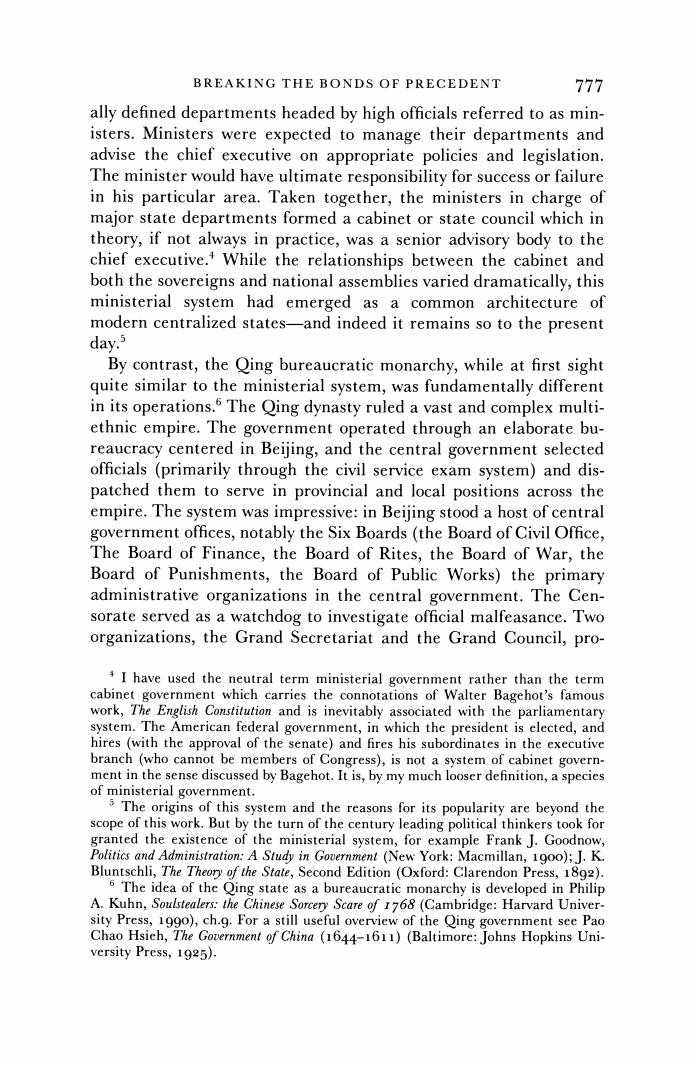正在加载图片...

BREAKING THE BONDS OF PRECEDENT 777 ally defined departments headed by high officials referred to as min- isters.Ministers were expected to manage their departments and advise the chief executive on appropriate policies and legislation. The minister would have ultimate responsibility for success or failure in his particular area.Taken together,the ministers in charge of major state departments formed a cabinet or state council which in theory,if not always in practice,was a senior advisory body to the chief executive.While the relationships between the cabinet and both the sovereigns and national assemblies varied dramatically,this ministerial system had emerged as a common architecture of modern centralized states-and indeed it remains so to the present day.5 By contrast,the Qing bureaucratic monarchy,while at first sight quite similar to the ministerial system,was fundamentally different in its operations.5 The Qing dynasty ruled a vast and complex multi- ethnic empire.The government operated through an elaborate bu- reaucracy centered in Beijing,and the central government selected officials (primarily through the civil service exam system)and dis- patched them to serve in provincial and local positions across the empire.The system was impressive:in Beijing stood a host of central government offices,notably the Six Boards(the Board of Civil Office, The Board of Finance,the Board of Rites,the Board of War,the Board of Punishments,the Board of Public Works)the primary administrative organizations in the central government.The Cen- sorate served as a watchdog to investigate official malfeasance.Two organizations,the Grand Secretariat and the Grand Council,pro- 4 I have used the neutral term ministerial government rather than the term cabinet government which carries the connotations of Walter Bagehot's famous work,The English Constitution and is inevitably associated with the parliamentary system.The American federal government,in which the president is elected,and hires (with the approval of the senate)and fires his subordinates in the executive branch (who cannot be members of Congress),is not a system of cabinet govern- ment in the sense discussed by Bagehot.It is,by my much looser definition,a species of ministerial government. 5 The origins of this system and the reasons for its popularity are beyond the scope of this work.But by the turn of the century leading political thinkers took for granted the existence of the ministerial system,for example Frank J.Goodnow, Politics and Administration:A Study in Government (New York:Macmillan,1goo);J.K. Bluntschli,The Theor of the State,Second Edition (Oxford:Clarendon Press,1892). 6 The idea of the Qing state as a bureaucratic monarchy is developed in Philip A.Kuhn,Soulstealers:the Chinese Sorcery Scare of 1768(Cambridge:Harvard Univer- sity Press,1990),ch.9.For a still useful overview of the Qing government see Pao Chao Hsich,The Government of China (1644-1611)(Baltimore:Johns Hopkins Uni- versity Press,1925).BREAKING THE BONDS OF PRECEDENT 777 ally defined departments headed by high officials referred to as ministers. Ministers were expected to manage their departments and advise the chief executive on appropriate policies and legislation. The minister would have ultimate responsibility for success or failure in his particular area. Taken together, the ministers in charge of major state departments formed a cabinet or state council which in theory, if not always in practice, was a senior advisory body to the chief executive.4 While the relationships between the cabinet and both the sovereigns and national assemblies varied dramatically, this ministerial system had emerged as a common architecture of modern centralized states-and indeed it remains so to the present day.5 By contrast, the Qing bureaucratic monarchy, while at first sight quite similar to the ministerial system, was fundamentally different in its operations.6 The Qing dynasty ruled a vast and complex multiethnic empire. The government operated through an elaborate bureaucracy centered in Beijing, and the central government selected officials (primarily through the civil service exam system) and dispatched them to serve in provincial and local positions across the empire. The system was impressive: in Beijing stood a host of central government offices, notably the Six Boards (the Board of Civil Office, The Board of Finance, the Board of Rites, the Board of War, the Board of Punishments, the Board of Public Works) the primary administrative organizations in the central government. The Censorate served as a watchdog to investigate official malfeasance. Two organizations, the Grand Secretariat and the Grand Council, pro- 4 I have used the neutral term ministerial government rather than the term cabinet government which carries the connotations of Walter Bagehot's famous work, The English Constitution and is inevitably associated with the parliamentary system. The American federal government, in which the president is elected, and hires (with the approval of the senate) and fires his subordinates in the executive branch (who cannot be members of Congress), is not a system of cabinet government in the sense discussed by Bagehot. It is, by my much looser definition, a species of ministerial government. 5 The origins of this system and the reasons for its popularity are beyond the scope of this work. But by the turn of the century leading political thinkers took for granted the existence of the ministerial system, for example Frank J. Goodnow, Politics and Administration: AStudy in Government (New York: Macmillan, 1900); J. K. Bluntschli, The Theory of the State, Second Edition (Oxford: Clarendon Press, 1892). 6 The idea of the Qing state as a bureaucratic monarchy is developed in Philip A. Kuhn, Soulstealers: the Chinese Sorcery Scare of 1768 (Cambridge: Harvard University Press, 1990), ch.9. For a still useful overview of the Qing government see Pao Chao Hsieh, The Government of China (1644-1611) (Baltimore: Johns Hopkins University Press, 1925)